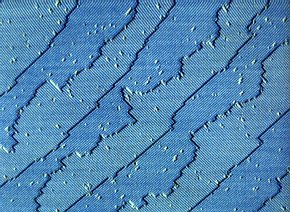Juan M. López
Non-equilibrium Statistical Mechanics and Complex Systems
Patterns and disorder
- Most systems in Nature are essentially disordered and seemingly random. If you wish, they show such an intrincate order and degree of organization that it is unpractical to speak about order and we prefer to call them complex systems. They also follow the laws of physics, even if in statistical terms. This makes them predictable and understandable with the appropriate mathematics.

- Fracture is a prominent example of fractal geometry in Nature.

- We say that complex systems are often scale-invariant or fractal. Similar patterns may appear at scales that range from kilometers to nanometers. Branching processes are a very common mechanism that is behind the formation of many fractal structures in Nature including river basins, tree branching, water frost crystals, the body's blood vessels, electric-breakdown, ... It provides a very efficient transport network with a minimal use of resources.

- This is typical pattern of sand that can be seen at the beach. The riddles have a scale that ranges from several centimeters to meters. Similar patterns also may appear at nanoscale during thin-film growth by bombardment of crystal surfaces with high-energy atoms. Actually, even the mathematical models that describe both systems are similar.

- The picture shows an atomic force microscope image of steps on a surface. The steps are one atom high!.
- Disclaimer: All images above are in the public domain and not my own work.


I am Senior Research Scientist at Instituto de Física de Cantabria (IFCA), which is joint research centre of the Spanish Scientific Research Council (Consejo Superior de Investigaciones Científicas, CSIC) and Universidad de Cantabria.
My research in brief
My current field of research is statistical physics and complex systems including out-of-equilibrium dynamics, critical behaviour, disordered systems, scale invariance, and space-time chaos.
I am interested in understanding how systems organize into dynamical states that exhibit patterns, forms, and complex structures. This organization often arises in a generic way from the interplay, on the one hand, of disorder, noise, and/or thermal fluctuations, and-- on the other hand-- nonlinear interactions among the individual components, particles or degrees of freedom. Nonlinearity is essential to bring upon some level of order or organization (however intricate) out of noise. This is what is nowadays called "complex behaviour", which is a fancy term to describe non-equilibrium statistical physics.
More details about my research and publications can be found navigating the top menu.
Short CV
In my scientific pilgrimage I enjoyed research positions in the Department of Mathematics at Imperial College London (1997-1999), Department of Physics at Universita La Sapienza in Rome (2000), and a Ramón y Cajal contract at IFCA (2001-2005). In 2005 I became permanent staff scientist at CSIC.
![]()